Wound care, injuries & healing of Pet Turkeys
Injuries, Injuries, the list goes on, broken leg, broken hip, Fox attack, Owl attack, breeding injuries, once a Spur wound. (only once!)
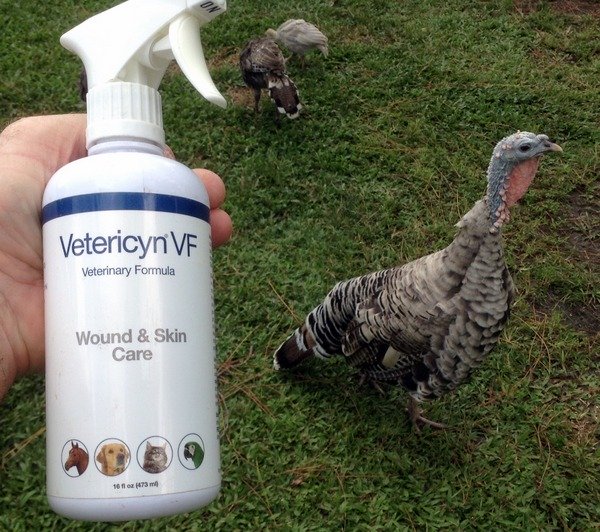
Well so far, the Vetericyn has worked the best. Expensive-yep
Actually, the list got me thinking: 16+ years of turkey raising-Lets see, there was the Pygmy Rattlesnake bite to a Tom's snood. (He survived, but his head was swollen for two weeks)
And the Predators:
There was the terrible week of the Great Horned Owl attacks (none of the turkeys who were bitten by those choppers survived)
The Barred owl attacks on little turkeys only, (the babies were just gone)
The bobcat attacks -50% survival (If the dogs and I got outside quick enough)
The neighbors golden retriever who plucked a turkey hen that was in their yard searching for a nesting location. When I finally rescued the turkey hen--She was featherless as any grocery store bird and yet fully recovered & is still alive five years later.
However, there was little Jack Russell Terrier that got in the yard and chased a broad breasted turkey until--heart attack? The overweight bird passed away.
I suppose, like anyone who has animals, there is a list of successes and miracles, losses and injuries that bring up the question of euthanasia to end suffering.
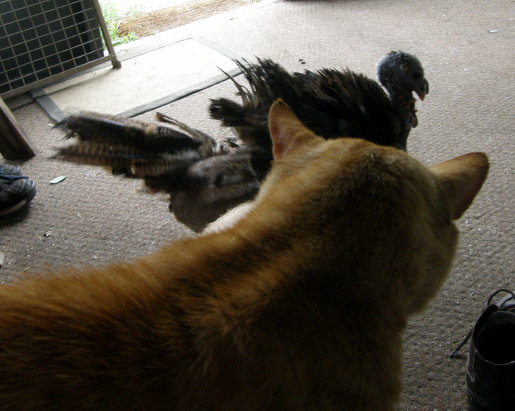
Butterball, she survived the fox attack defending her babies. But lost a huge section of back feathers and a received a terrible (deep) wound to the back.
She pulled through and is now approaching 14-15 years of age?
(The cat just wants to knead my leg until I yell)
I guess the first thing that should be mentioned,--and something that shocked us is the Turkey's nearly magical ability to heal themselves. Truly stunning ability.
Perhaps all animals (including people have the ability)
So far.....A good rule of thumb.....if the injured bird survives the first three days, she will make a full recovery except for the knitting of internal bones.
Best list of turkey medicines I have found so far

The Christmas day attack.... (2017)
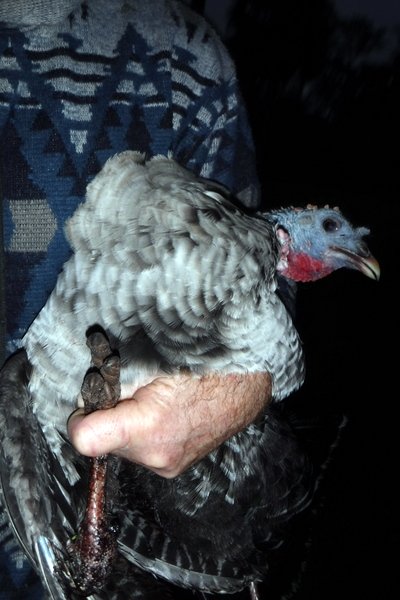
Walked out of the house at daylight on Christmas morning to open the chicken coop and turkey pens housing the old timers. The birds on roost had not yet flown down; but did so calling out some fly-down-cackles as the sun peeked through the pine trees.
Beautiful Florida morning, but my attention was on a bird giving off a lost turkey call somewhere in a neighbors yard. The same call that the teenage turkeys sound when they have not yet learned to fly over a fence and are left behind by the flock.
Although I did not understand why the bird was out of the yard at daylight, I took an early morning stroll to bring the turkey home.
What I found was an adult hen. Was she nesting already? But then I saw that she had been mangled from her lower chest to her legs to under her right wing. She could not fly over the fence.
I trapped her against the fence and quickly grabbed her, ---not that she was moving very fast.
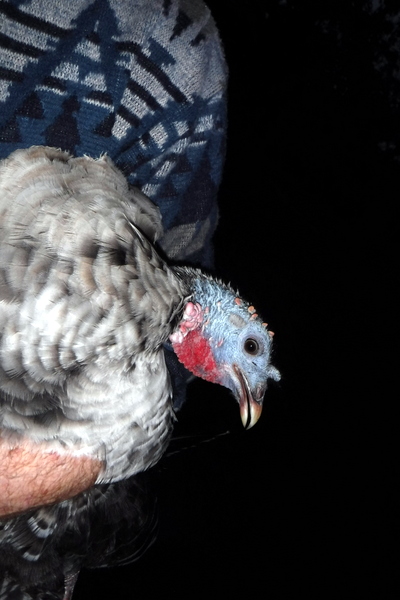
Found her just after dawn with terrible wounds....Coyote?
Inspected her wounds--extensive and horrifying----dismaying as I did not think she would survive.
Carried her home, took these few photos.
I have decided not to post the worst (internet is already full of that)
I held the turkey hen while my wife spayed the wound (one giant wound across half of her body with Vetericyn.
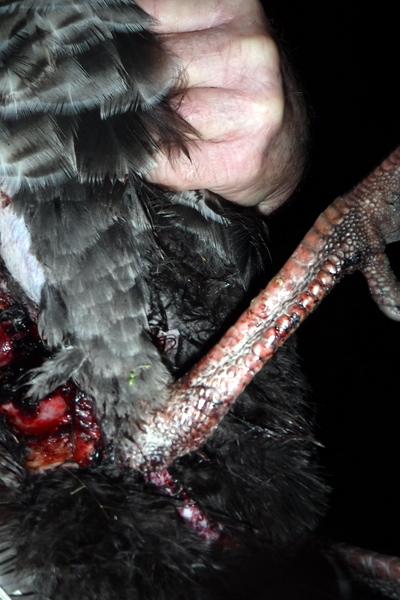
Will not show the worst wound photos
We locked her up in one of our hospital pens. Food, water and clean shavings. Kept the area dim to dark to wait out the three days that more or less mark whether the turkey will survive.
Today, the thirteenth day after her attack I let her out to warm in the sun.
For the past week I have been giving her snacks--tomato leaves, small pieces of banana, other fresh greens. She has been trying to perch in the pen. But cannot hop up to the waist high branch----I'm not sure of the muscle damage.
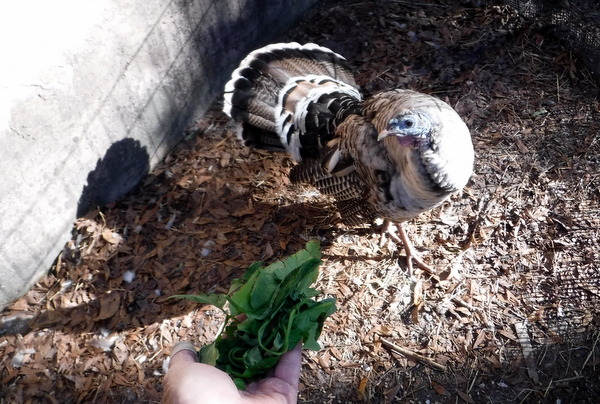
First day outing in the sun-She looks good. (as long as you sort of ignore looking the giant wound under her wing)
First day out of the hospital pen for a little warming sunlight. (This has been a cold Florida week)
I gave her some fresh tomato leaves that I managed to keep alive during the recent freeze and gave her some late season beauty berries I found. (the chickens were quite jealous)
The turkey hen has a good appetite and picks at her wounds. I still cannot say for certain if she will ever fly again (or even if she is going to survive).
However I think in a couple of weeks she will start her own rehabilitation. In the meantime I have been placing an old hen in her pen for companionship.
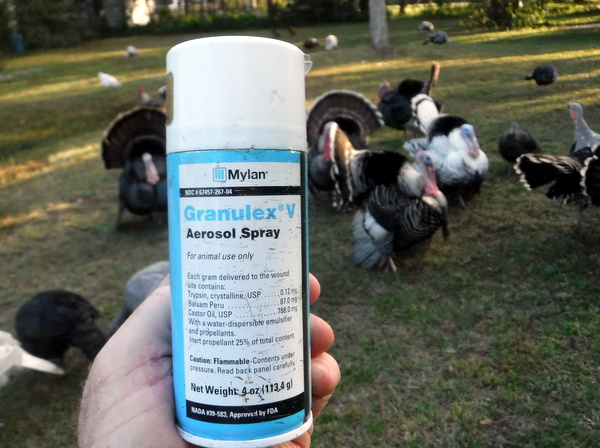
I have been spraying the wound (and giant hole in her side) with "Granulex" the best medicine I have seen for healing and granulating wounds. All the more surprising since the main ingredient is Castor oil.......We have been using it on our wolfhounds for twenty years. (not for infection, but the healing of cuts/wounds)
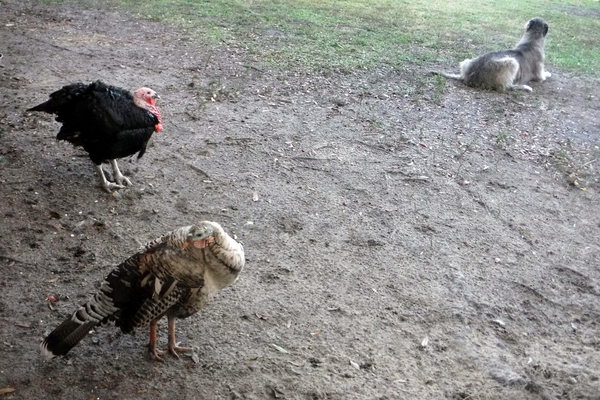
First walk outside of the hospital pen. (Separate yard from the main flock)
Actually the hen did not want to remain outside for very long. I put her back in the pen and gave her more fresh greens and plenty of high protein food.
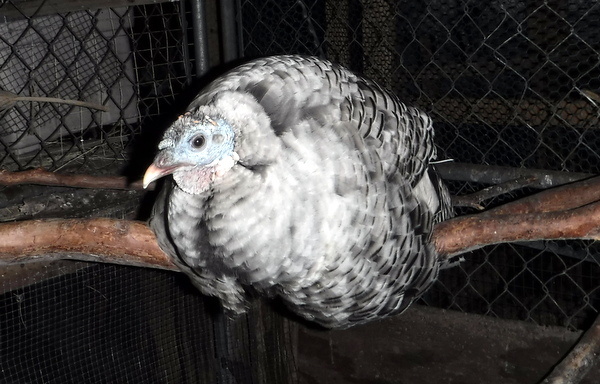
However she only perched once. I think there is extensive muscle damage that will not permit her to sit a branch.
Exactly 14 days after her attack/mauling, she managed the short flight to a waist high perch for the night. Although she did not verbalize the happy sounds many of the young birds do when roosting-I assume she was very happy to be off the ground.
And sort of demonstrates the turkey's nearly magical ability to heal themselves-I would hazard a guess that natural selection/evolution allows the turkeys to heal quickly to reproduce and the slow healers are eaten by....Well every thing loves turkey.
I digress..... Her wound is so severe that I am expecting two or three more weeks in the hospital pen before she can be allowed back in the general flock.
Update> the last statement was surprisingly wrong.
She has not been moved to the flock. On March 23, nearly three months after her attack, the wound had closed to the point where I could move her outside. (Some late winter cold weather delayed me)
She can walk, but with a severe limp. And she does not perch and has never done a dust bath. I currently have her in an outside pen where she can see the other turkeys. For companionship, she has our 17 year old male tom turkey.
This has been by far the worst wound to recover from. However the fact that she did survive really points to some magic like abilities to heal.
Update: July: she has baby turkeys and the miracle that her poults survived a Flood

A other few stories come to mind that really demonstrates their healing powers:
We had a very young hen break her leg. My wife splinted it and wrapped the splint wet vet-wrap. We locked the hen in a secure pen to wait out the healing period.
The young hen was on her belly, not very happy at being alone, however she needed quiet time to heal.
After about five days, I walked over to inspect her and she was perching on the broken leg! A few days later she was walking-with a limp. And shortly after that she removed the splint with her beak!
If I had not seen it--I would have thought healing that quickly impossible.... We still did not let her out of the hospital pen for another week.
Young turkeys are rambunctious.

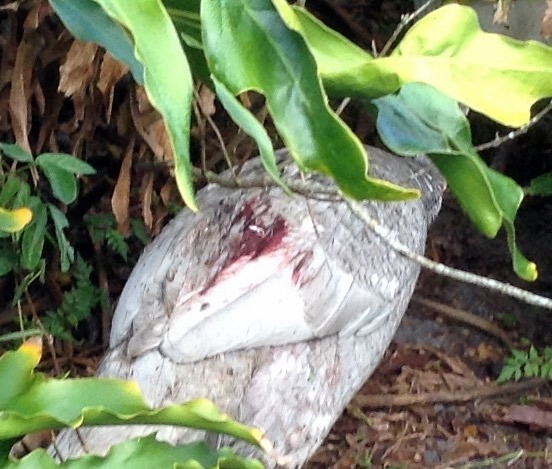
Hen's torn back from mating with the heavier Toms.
These claw wounds were not to life threatening, however there have there have been far worse breeding wounds (including broken hips)
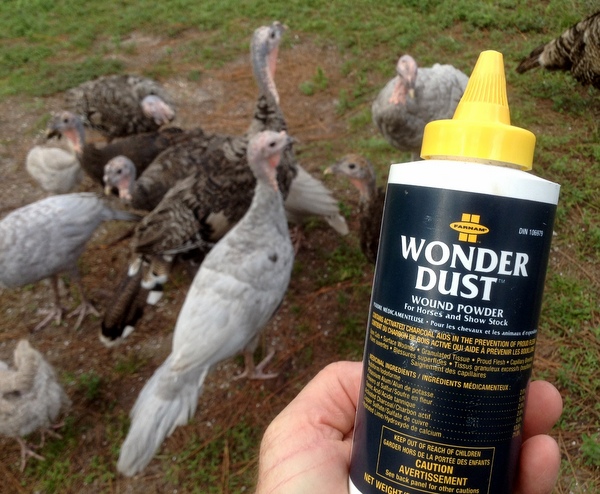
This powder has worked good on smaller cuts/bites

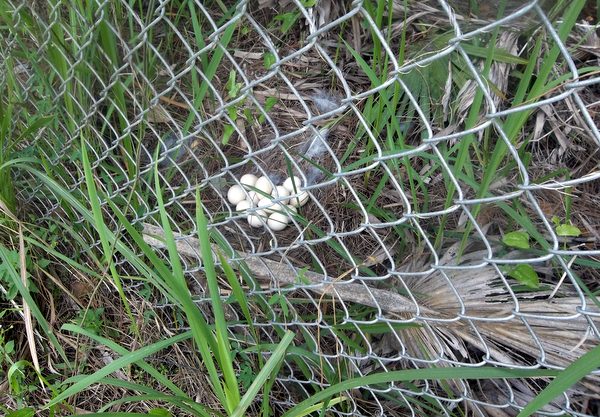
Discovered this nest behind a fence I could not cross
The Chain Link fence attack
This past spring one of our turkey hens jumped the neighbors chain link fence to nest in his horse pasture. This hen had used the same location of tall grass for at least four years.
Since I could not hop this fence, I would go look every day when I arrived home from work. -Look for hatched eggs or the opposite, a raid by a nocturnal predator.
This nest was behind a chain link fence I could not cross however looking through the fence I could see a huge amount of feathers strewn about, indicating the hen had had a night attack.
She was still alive and I could even see some eggs under her. However by the way she was picking at her chest, I knew she was injured.
----The hen and remaining eggs had to be relocated, for undoubtedly the predator would return that night. And her wounds-whatever they might be needed attention.
I telephoned my neighbor at his work on the space center and with a bucket and arm guard; waited for him to open his gate. When he arrived home we walked to the grassy spot, I slipped on my arm guard reached under the hen and collected the eggs, placing them in the bucket. Around me I could see feathers and blood on the ground ---a lot of blood and my gloved hand came out from under her stained red. And the eggs were stained brown from blood. How bad was the wound?
With the eggs in the bucket, I quickly grabbed the wounded hen, pinning her wings to side and performed a quick inspection. The skin had been flayed from her chest and was hanging tattered shreds, under that-a horrible wound. I carried her and the eggs home.
My wife was not home so I had to clean and fully inspect the damage while holding the turkey with one hand. Bad wound however the body cavity did not appear to be punctured. Out of desperation, I squirted an entire tube of triple antibiotic ointment into her chest wound and attempted to wrap the hen in gauze to hold her skin in place. The gauze wrap proved to be impossible to stay on and I opted to lock her up without the wrapping.
-I did follow the 1911 veterinarian book's suggestion and placed the hen in a dimly lit pen to recover. After two days I moved her to a well lit pen, but kept her locked up for 2 to 3 weeks and she had a complete recovery.
Her eggs? I wiped the blood from the eggs and placed them in an incubator. Not knowing if they were due in two days or 28 days. After three weeks I did a cold test and all the eggs turned out to be liquid. The hen had almost lost her life protecting unfertilized eggs.
Working on a few more stories. --Broken hips & Spraddle-leg deformity
In the "Bobbles" story, I mention the new poult and chick deformity (some say injury) known a Spraddle-leg (or as we termed the poults "Spinners")
Spraddle-leg –a condition where the new poults or chicks loose control of one or both legs. One or both legs are held out to the side. Sometimes it is called splayed leg.
I suspect that "splayed leg" is more of an tendon injury and easier fixed. Spraddle-leg---I am just not sure.
---I am surprised to read how common the problem is and that many people have successfully raised turkeys, guineas and chickens that had suffered from Spraddle-leg deformity/injury.
So far we have had 100% mortality rate. The causes are listed as incubator problems or inbreeding.
Suggestions for curing splayed leg in pea fowl and splayed leg in guineas

Return Home from Turkey Injuries and Healing page

My next book "Surviving Kennedy Space Center" available on Amazon, September 16, 2025
Peek behind the curtains of the space center
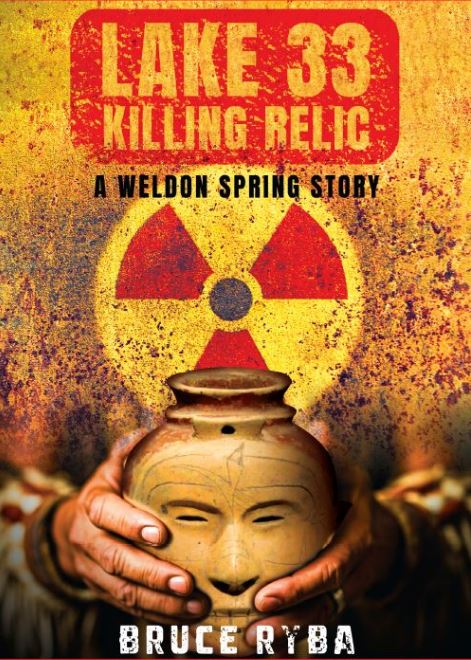
Lake 33 Killing Relic (navigates to my other web site)
Eastern Missouri, a little radioactive waste and a possible ghost, what could go wrong?
Do you need the perfect gift?
For pet lovers around the globe, "It's a Matter of Luck" is a collection of heart warming stories of horse rescues from the slaughterhouse.
Available on Amazon:
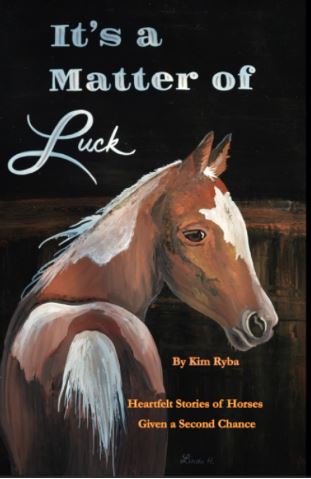
It's a Matter of Luck: Inspirational, Heartfelt Stories of Horses Given a Second Chance.
by Kim Ryba & Lina T. Lindgren
Warning: This book may cause your eyes to water -in a good way. (speaking from experience after reading it)
Please give Kim and Lina a heartfelt review on Amazon!

Author Bruce Ryba at Kennedy Space Center Launch Pad 39B & Artemis 1. "We are going to the Moon!"
Author's discussion (that's me) on You Tube of a book review on Amazon
My Facebook page Pet Turkeys You can always check in and say hello!
For the video versions of information, please check out my YouTube Channel (Turkeys, KSC, Flintknapping, dive stories etc.)
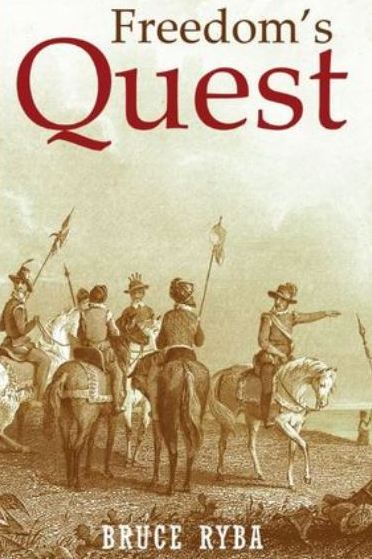
Book One of Florida History:
Freedoms Quest Struggle for the Northern Frontier and lost tales of old Florida
Fiction & language warning.
Available on Amazon
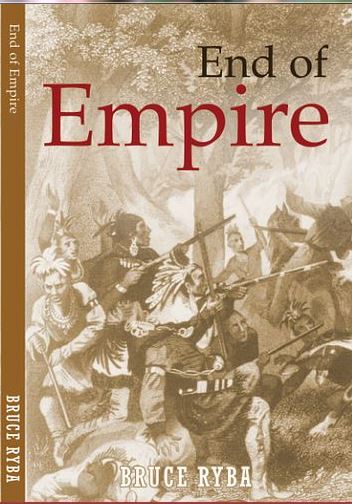
Desperate times call for bold action.
In a desperate move to retain Florida and protect the treasure-laden galleons on their dangerous return journey to Europe, the King of Spain issues a royal decree offering refuge to all English slaves who escape Florida and pick up a musket to defend the coquina walls of Saint Augustine.
In another bold gamble, the King offers refuge to the dissatisfied Indian nations of the southeast who will take up arms against the English.
Clans, traumatized by war and disease, cross the Spanish Frontier to settle the cattle-rich land and burned missions of Florida.
Follow the descendants of the conquistador Louis Castillo in remote Spanish Florida, a wildland swept by diseases, hurricanes, and northern invasions.
Book Two: Available on Amazon

